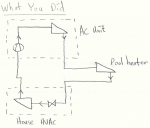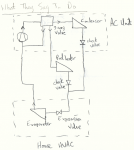Went to bed before I finished my post, and it looks like it's mostly been answered, but I'll throw in my two cents and diagrams anyway.
Okay, so first off, I'm not an HVAC guy. We did cover all sorts of heat cycles, including heat pumps, in my thermodynamics classes in college.
Firstly, let's look at a normal AC system. This consists of four main parts, so far as the refrigerant is concerned. These are the compressor, condenser, expansion valve, and evaporator. The compressor takes vapor and compresses it. It is now very hot, and is piped through the condenser, where it is cooled and condenses by a fan drawing air across it (the condenser fan, which you called the compressor fan). This liquid refrigerant, now closer to ambient temp, is piped into the house. Once at your HVAC system, it is pushed through an expansion valve. This causes it to rapidly drop in temperature, and some of the liquid becomes vapor. The rest of the liquid evaporates in, well, the evaporator, which is the set of coils inside your HVAC unit (what makes the air in your house cold). Now completely vapor, the refrigerant makes its way back to the compressor in the outdoor unit to start all over again.
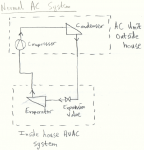
Now let's go over how the manufacture said to install this. I referenced the Hotspot FPH brochure as well, as it was a little more descriptive and has the exact same setup. They need you to intercept the refrigerant line between the condenser and compressor and install a 3-way valve. You then need to tap the line after the condenser and add a check valve. One connection on the 3-way valve goes to the evaporator (suction) line, which should be the bigger, insulated line coming out of the ground. The other connection runs to the pool heater. After the pool heater is another check valve, before the two lines tee together and run into the house as normal.
According to the Hotspot FPH brochure, what the 3-way valve does is swap refrigerant flow between either the condenser or the pool, based on a thermostat that measures the pool temp. It also evacuates either the condenser coil or the pool heater coil, whichever isn't being used, likely so the overall system charge is not changed much. That's what the connection to the suction line is for, along with the check valves. Note that the 3-way valve (and check valve) doesn't have to be inside the AC Unit as I've drawn, but you
will need to tap lines inside the AC unit to install it, as you need to tap between the compressor and condenser, and that line doesn't come outside of the AC unit.
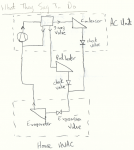
From what you've said, and the pictures you've posted, I believe this is how you actually connected things. While not remotely like the manufacture outlines, if it is actually how you installed it it
should work (again, I'm not an HVAC guy, and this isn't ideal, which I cover below). If this is how it was installed, then your only "issue" is that the wrong type or amount of refrigerant was put into the system after it was connected.
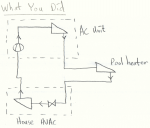
Now, what's actually wrong with how you did it? You didn't put the pool heater on a 3-way, pool water thermostatically controlled valve (along with the check valves). The first issue with this:
1) it won't reject much heat into the pool water as even with the condenser fan switched off you'll end up rejecting a considerable amount of heat through the condenser just by convection.
The condenser is still in the loop, and has a ton of fins. You'll loose a good bit of heat even with the fan off, before the refrigerant makes it to the pool heater. Additionally, I wouldn't be surprised if the compressor wanted some of that airflow to help keep from overheating, in which case shutting off the fan is a bad idea, but I'm not certain on that.
Second issue: Lack of heat regulation in your pool. The primary purpose of the 3-way valve is to switch between pool heating and normal AC operation. This is based on pool water temp so you don't, for example, heat your pool when it's 100 °F out and your pool water is already 95 °F. Now, most of the heat is lost in the condensing process, so the pool heat gain is minimal if the condenser fan is running, but there will still be some.
I think the biggest issue with your setup is that the manual fan switch may cause the compressor to overheat, especially being surrounded by hot condenser coils (but I'm not an expert, not sure if this would be the case. It seems logical though). If the 3-way valve was installed, then when not heating your pool, the condenser coils would be evacuated, so they'd be cool, and the condenser fan would be running still, so the compressor would stay cool. Actually it would stay cooler than normal, likely leading to better efficiencies.
The other thing is that instead of being a fully automatic setup, the manual switch means you have to physically switch the system from heating the pool to not heating the pool.
My uneducated summary is that your setup should, in theory, work, though not as well as if it was installed as designed with the 3-way thermostatically controlled valve and check valves.
It will cause the compressor to run hotter than designed, with potential negative effects. It's likely that the tech put the wrong or too little refrigerant into your system. If he charged it with the amount specified, it's likely underfilled, and underfilled systems freeze up the evaporators (another bit the 3-way valve takes care of, since it evacuates the unused coil, so the total amount of refrigerant shouldn't change). He should have charged it using pressure gauges instead.
Clever system though, when installed as directed. I may consider adding it to our house. Of course the obvious problem for me is peak AC usage is also the hottest time of the year, and we may not want additional heat at that point, so the cost/benefit may not be worth it. Likely better for the OP, being in Florida, as I imagine you use AC year-round down there. For myself, I'll look into putting a data logger for AC run time and pool temp throughout the year, then next winter compare the data and see if it would help with our particular location/pool/temps.





